Abstract
Since its original description the diagnosis of word deafness has been greatly expanded. Confusion has arisen with regard to the usage of the related terms pure word deafness, auditory agnosia, and cortical deafness. Three new cases of word deafness are presented including one case with CT and necropsy correlation. These cases are compared with 34 previously reported cases of various cortical auditory disorders. Our review establishes that patients with word deafness who have had formal testing of linguistic and non-linguistic sound comprehension and musical abilities always demonstrated a more pervasive auditory agnosia. Despite the spectrum of auditory deficits and associated language abnormalities, patients with word deafness share common features including aetiology, pathology, clinical presentation and course. These common features justify inclusion of heterogeneous cortical auditory disorders under the rubric of word deafness. Despite some limitations the term "word deafness" should be retained for this syndrome, since inability to comprehend spoken words is the most distinctive clinical deficit. Word deafness is most frequently caused by cerebrovascular accidents of presumed cardiac embolisation, with bitemporal cortico-subcortical lesions. The sequence of cerebral injury is not predictive of resulting auditory deficits. Impairment of musical abilities parallels the severity of the auditory disorder.
Full text
PDF
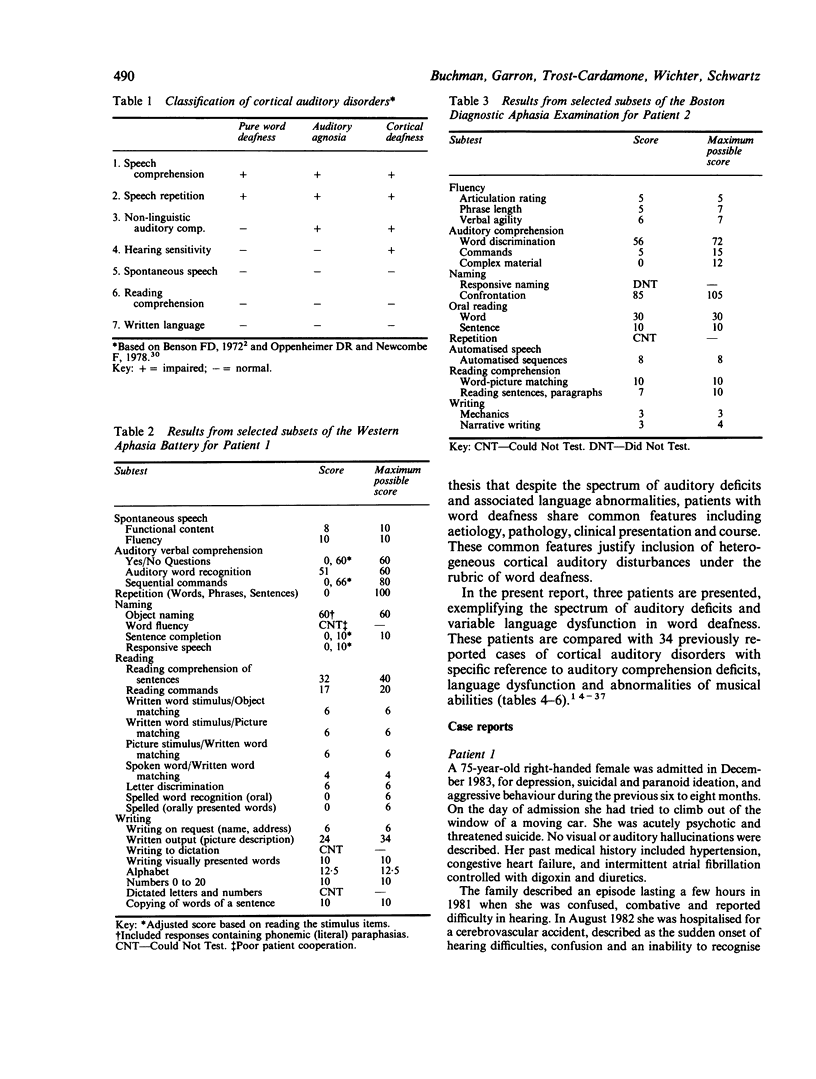


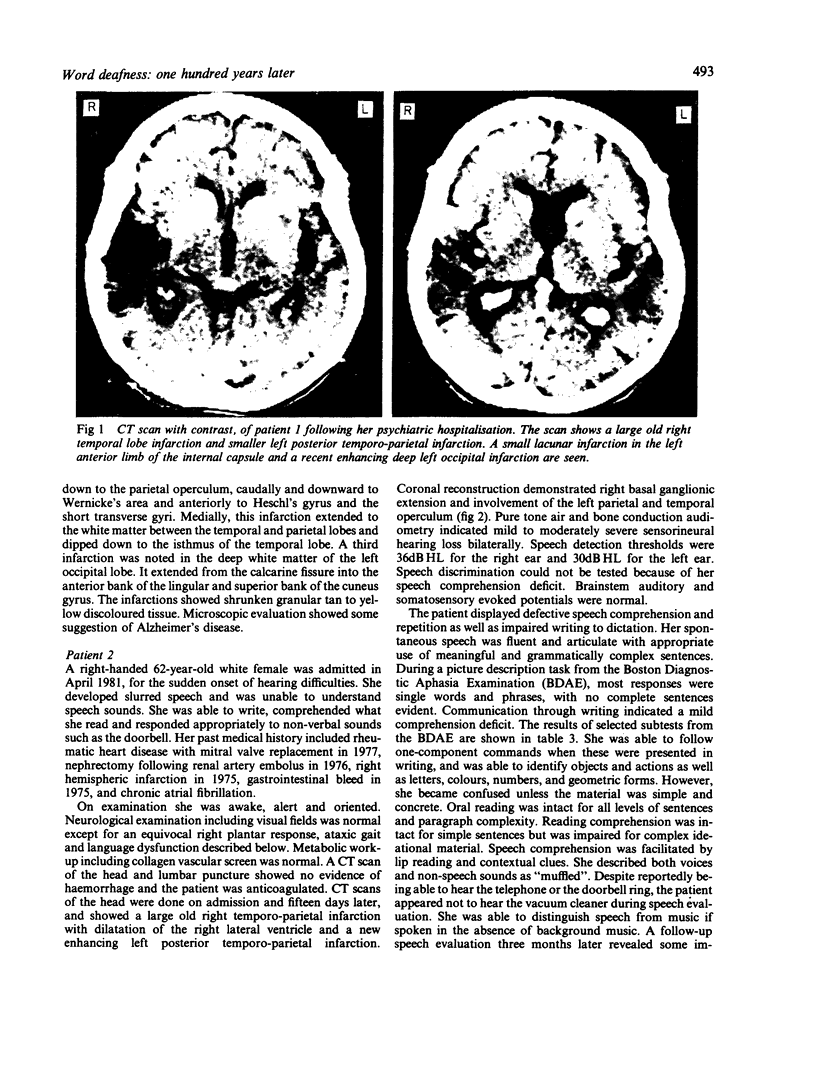
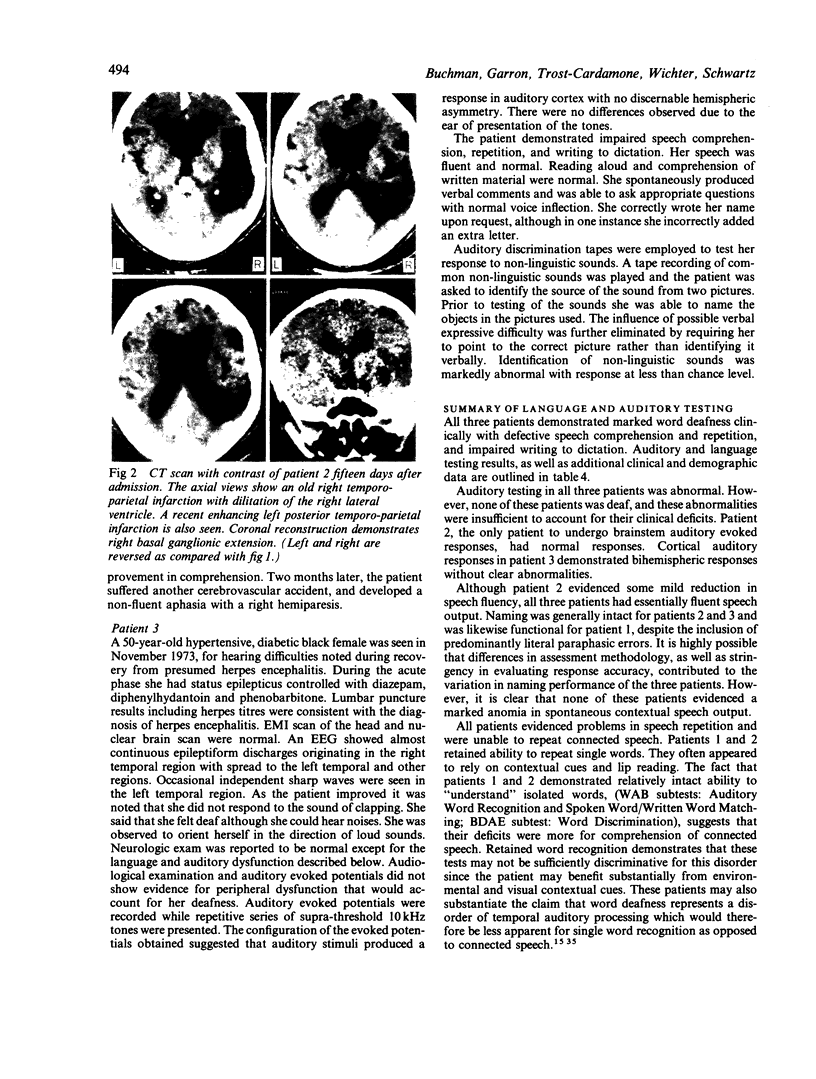


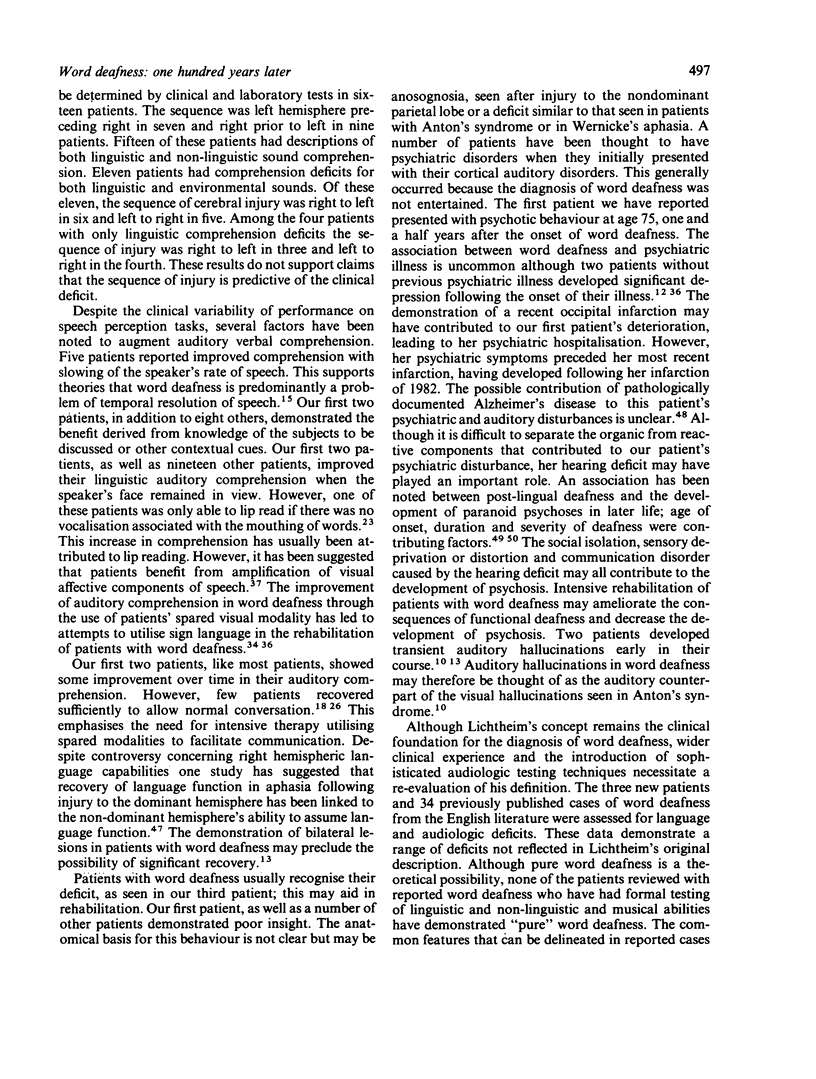
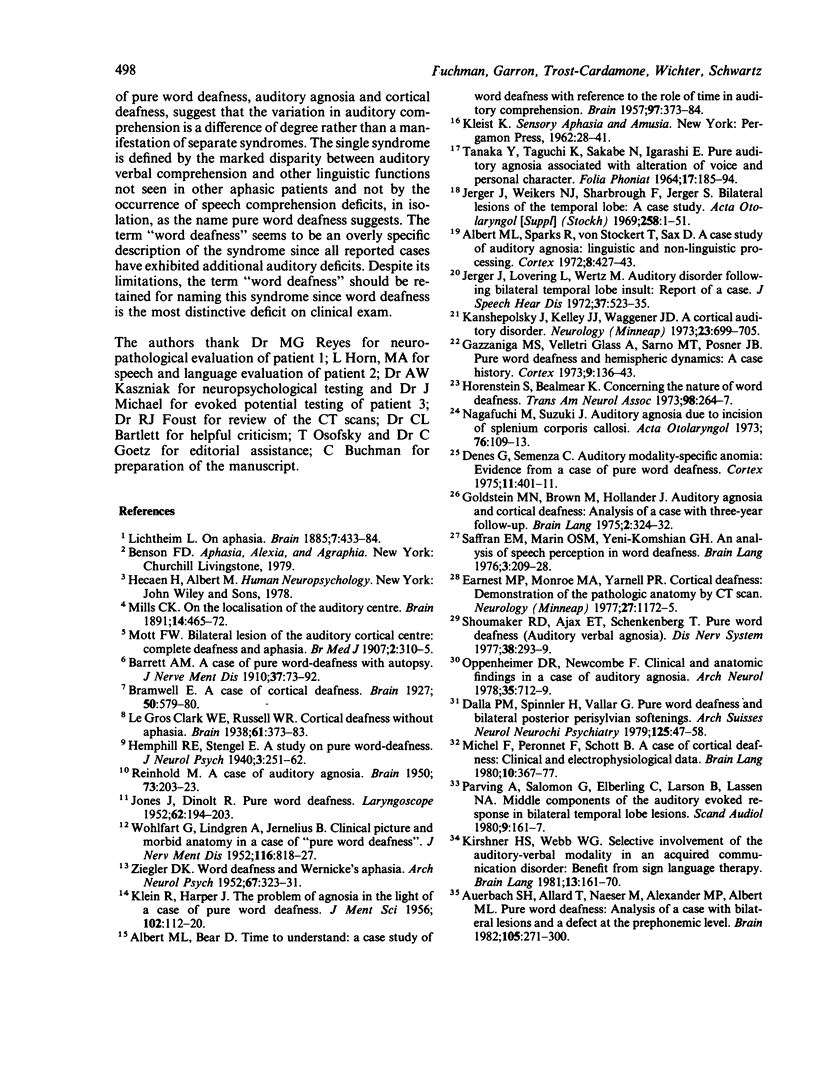
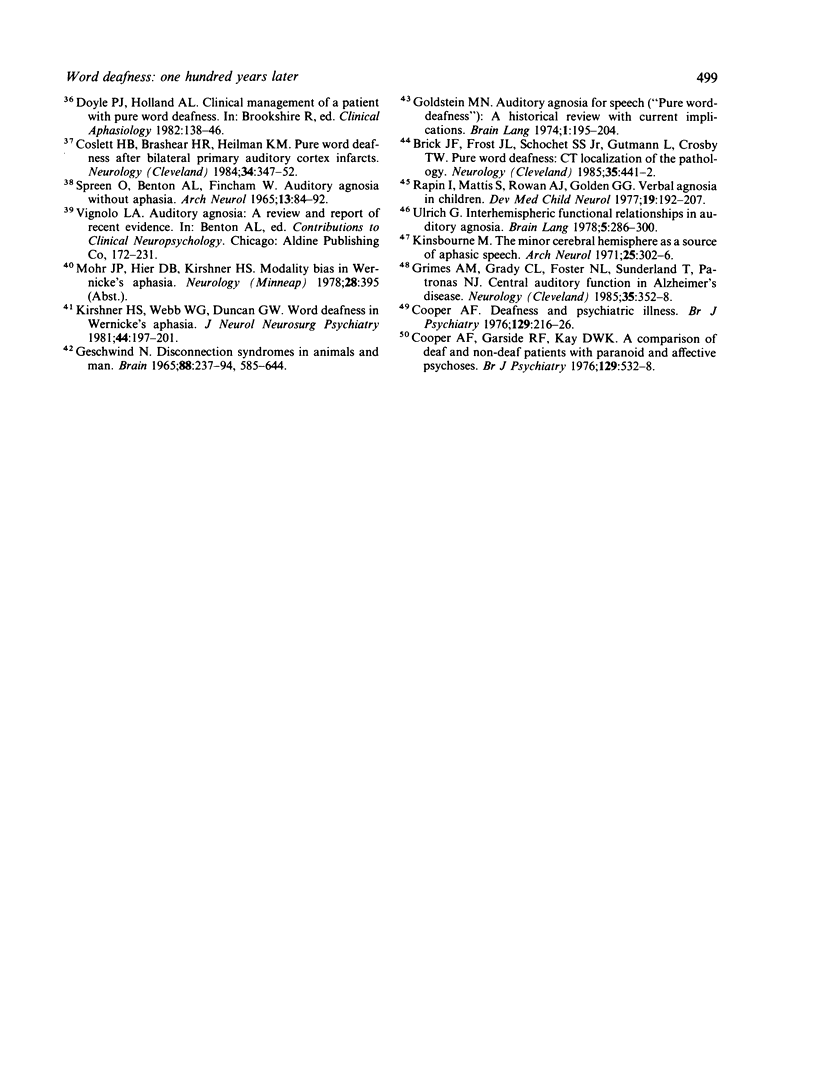
Images in this article
Selected References
These references are in PubMed. This may not be the complete list of references from this article.
- Albert M. L., Bear D. Time to understand. A case study of word deafness with reference to the role of time in auditory comprehension. Brain. 1974 Jun;97(2):373–384. doi: 10.1093/brain/97.1.373. [DOI] [PubMed] [Google Scholar]
- Albert M. L., Sparks R., Von Stockert T., Sax D. A case study of auditory agnosia: linguistic and non-linguistic processing. Cortex. 1972 Dec;8(4):427–443. doi: 10.1016/s0010-9452(72)80006-6. [DOI] [PubMed] [Google Scholar]
- Auerbach S. H., Allard T., Naeser M., Alexander M. P., Albert M. L. Pure word deafness. Analysis of a case with bilateral lesions and a defect at the prephonemic level. Brain. 1982 Jun;105(Pt 2):271–300. doi: 10.1093/brain/105.2.271. [DOI] [PubMed] [Google Scholar]
- Baker A. B. [A tribute to Russell DeJong, founding Editor-in-chief]. Neurology. 1977 Jan;27(1):1–2. doi: 10.1212/wnl.27.1.1. [DOI] [PubMed] [Google Scholar]
- Cooper A. F. Deafness and psychiatric illness. Br J Psychiatry. 1976 Sep;129:216–226. doi: 10.1192/bjp.129.3.216. [DOI] [PubMed] [Google Scholar]
- Cooper A. F., Garside R. F., Kay D. W. A comparison of deaf and non-deaf patients with paranoid and affective psychoses. Br J Psychiatry. 1976 Dec;129:532–538. doi: 10.1192/bjp.129.6.532. [DOI] [PubMed] [Google Scholar]
- Coslett H. B., Brashear H. R., Heilman K. M. Pure word deafness after bilateral primary auditory cortex infarcts. Neurology. 1984 Mar;34(3):347–352. doi: 10.1212/wnl.34.3.347. [DOI] [PubMed] [Google Scholar]
- Dalla Pria M., Spinnler H., Vallar G. Pure word deafness and bilateral posterior perisylvian softenings: report of a case with neuropsychological-C.A.T. correlation. Schweiz Arch Neurol Neurochir Psychiatr. 1979;125(1):47–58. [PubMed] [Google Scholar]
- Denes G., Semenza C. Auditory modality-specific anomia: evidence from a case of pure word deafness. Cortex. 1975 Dec;11(4):401–411. doi: 10.1016/s0010-9452(75)80032-3. [DOI] [PubMed] [Google Scholar]
- Gazzaniga M. S., Glass A. V., Sarno M. T., Posner J. B. Pure word deafness and hemispheric dynamics: a case history. Cortex. 1973 Mar;9(1):136–143. doi: 10.1016/s0010-9452(73)80022-x. [DOI] [PubMed] [Google Scholar]
- Geschwind N. Disconnexion syndromes in animals and man. I. Brain. 1965 Jun;88(2):237–294. doi: 10.1093/brain/88.2.237. [DOI] [PubMed] [Google Scholar]
- Goldstein M. N., Brown M., Hollander J. Auditory agnosia and cortical deafness: analysis of a case with three-year followup. Brain Lang. 1975 Jul;2(3):324–332. doi: 10.1016/s0093-934x(75)80073-3. [DOI] [PubMed] [Google Scholar]
- Grimes A. M., Grady C. L., Foster N. L., Sunderland T., Patronas N. J. Central auditory function in Alzheimer's disease. Neurology. 1985 Mar;35(3):352–358. doi: 10.1212/wnl.35.3.352. [DOI] [PubMed] [Google Scholar]
- JONES J., DINOLT R. Pure word deafness. Laryngoscope. 1952 Feb;62(2):194–203. doi: 10.1288/00005537-195202000-00005. [DOI] [PubMed] [Google Scholar]
- Jerger J., Lovering L., Wertz M. Auditory disorder following bilateral temporal lobe insult: report of a case. J Speech Hear Disord. 1972 Nov;37(4):523–535. doi: 10.1044/jshd.3704.523. [DOI] [PubMed] [Google Scholar]
- Jerger J., Weikers N. J., Sharbrough F. W., 3rd, Jerger S. Bilateral lesions of the temporal lobe. A case study. Acta Otolaryngol Suppl. 1969;258:1–51. [PubMed] [Google Scholar]
- KLEIN R., HARPER J. The problem of agnosia in the light of a case of pure word deafness. J Ment Sci. 1956 Jan;102(426):112–120. doi: 10.1192/bjp.102.426.112. [DOI] [PubMed] [Google Scholar]
- Kanshepolsky J., Kelley J. J., Waggener J. D. A cortical auditory disorder. Clinical, audiologic and pathologic aspects. Neurology. 1973 Jul;23(7):699–705. doi: 10.1212/wnl.23.7.699. [DOI] [PubMed] [Google Scholar]
- Kinsbourne M. The minor cerebral hemisphere as a source of aphasic speech. Arch Neurol. 1971 Oct;25(4):302–306. doi: 10.1001/archneur.1971.00490040028003. [DOI] [PubMed] [Google Scholar]
- Kirshner H. S., Webb W. G. Selective involvement of the auditory-verbal modality in an acquired communication disorder: benefit from sign language therapy. Brain Lang. 1981 May;13(1):161–170. doi: 10.1016/0093-934x(81)90136-x. [DOI] [PubMed] [Google Scholar]
- Michel F., Peronnet F., Schott B. A case of cortical deafness: clinical and electrophysiological data. Brain Lang. 1980 Jul;10(2):367–377. doi: 10.1016/0093-934x(80)90062-0. [DOI] [PubMed] [Google Scholar]
- Nagafuchi M., Suzuki J. Auditory agnosia due to incision of splenium corporis callosi. Acta Otolaryngol. 1973 Aug-Sep;76(2):109–113. doi: 10.3109/00016487309121488. [DOI] [PubMed] [Google Scholar]
- Oppenheimer D. R., Newcombe F. Clinical and anatomic findings in a case of auditory agnosia. Arch Neurol. 1978 Nov;35(11):712–719. doi: 10.1001/archneur.1978.00500350016004. [DOI] [PubMed] [Google Scholar]
- Parving A., Salomon G., Elberling C., Larsen B., Lassen N. A. Middle components of the auditory evoked response in bilateral temporal lobe lesions. Report on a patient with auditory agnosia. Scand Audiol. 1980;9(3):161–167. doi: 10.3109/01050398009076350. [DOI] [PubMed] [Google Scholar]
- REINHOLD M. A case of auditory agnosia. Brain. 1950 Jun;73(2):203–223. doi: 10.1093/brain/73.2.203. [DOI] [PubMed] [Google Scholar]
- Rapin I., Mattis S., Rowan A. J., Golden G. G. Verbal auditory agnosia in children. Dev Med Child Neurol. 1977 Apr;19(2):197–207. [PubMed] [Google Scholar]
- SPREEN O., BENTON A. L., FINCHAM R. W. AUDITORY AGNOSIA WITHOUT APHASIA. Arch Neurol. 1965 Jul;13:84–92. doi: 10.1001/archneur.1965.00470010088012. [DOI] [PubMed] [Google Scholar]
- Saffran E. M., Marin O. S., Yeni-Komshian G. H. An analysis of speech perception in word deafness. Brain Lang. 1976 Apr;3(2):209–228. doi: 10.1016/0093-934x(76)90018-3. [DOI] [PubMed] [Google Scholar]
- Shoumaker R. D., Ajax E. T., Schenkenberg T. Pure word deafness. (Auditory verbal agnosia). Dis Nerv Syst. 1977 Apr;38(4):293–299. [PubMed] [Google Scholar]
- TANAKA Y., TAGUCHI K., SAKABE N., IGARASHI E. PURE AUDITORY AGNOSIA ASSOCIATED WITH ALTERATION OF VOICE AND PERSONAL CHARACTER. A CASE REPORT. Folia Phoniatr (Basel) 1965;17:185–194. doi: 10.1159/000263041. [DOI] [PubMed] [Google Scholar]
- Ulrich G. Interhemispheric functional relationships in auditory agnosia. An analysis of the preconditions and a conceptual model. Brain Lang. 1978 May;5(3):286–300. doi: 10.1016/0093-934x(78)90027-5. [DOI] [PubMed] [Google Scholar]
- WOHLFART G., LINDGREN A., JERNELIUS B. Clinical picture and morbid anatomy in a case of pure word deafness. J Nerv Ment Dis. 1952 Dec;116(6):818–827. doi: 10.1097/00005053-195212000-00034. [DOI] [PubMed] [Google Scholar]
- ZIEGLER D. K. Word deafness and Wernicke's aphasia; report of cases and discussion of the syndrome. AMA Arch Neurol Psychiatry. 1952 Mar;67(3):323–331. doi: 10.1001/archneurpsyc.1952.02320150056005. [DOI] [PubMed] [Google Scholar]




